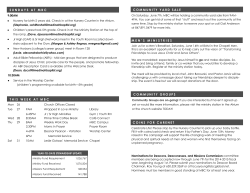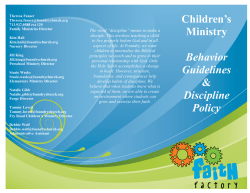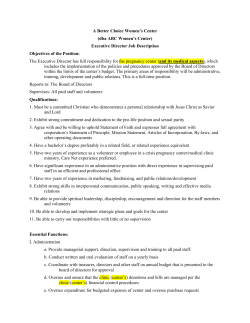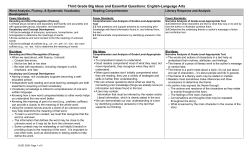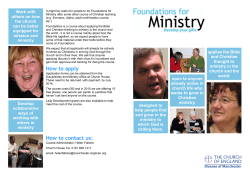
H ow to Create a Narrative Budget in Your Church
What is a narrative budget and why use one? Your budget is the sacred story of the ministry of your church. A narrative budget is an excellent way to communicate the ministry that has been accomplished through your church. It doesn’t replace a line-item budget, but it tells the following: • What is being accomplished • How donations are making a difference in the church and wider community • How the congregation supports mission and ministry Visit CovChurch.org/stewardship for tools to help you get started on your narrative budget, including: • Excel templates of narrative budget spreadsheets • Examples of narrative budgets • A PowerPoint presentation that outlines and illustrates the concept of a narrative budget How to Create a Narrative Budget in Your Church A Stewardship & Generosity Resource Special thanks to the Anglican Diocese of Niagara for sharing ideas and content for this brochure. Use a narrative budget in your visitor packets to connect them immediately to your ministry and your need for their participation. It is never too early to invite new people into your story. STEWARDSHIP COMMISSION STEWARDSHIP COMMISSION How does it work? A traditional budget consists of line items like salaries, You are a people of God, continuously responding to God’s call. Every congregation has an exciting faith story to tell. As the church we have a responsibility to share the story of our mission and how we live our life together. A narrative budget can be one small piece of this process, reshaping what seems to be simply an administrative task into an integrated story of congregational life. How you raise money—and how you spend it—are defining characteristics of who you truly are. By connecting your budget with the stories of how you worship, nurture your community, and reach out to the world beyond, you paint a picture of how you offer faithful mission to your members, your adherents, and your communities. utilities, property expenses, office supplies, and any deficit from last year. A narrative budget expands that process by telling the stories of your ministries and illustrating how your donations were used. How to create a narrative budget A narrative budget provides a much clearer picture of who you are and how you serve the community. It also offers a useful understanding of the pastor’s role, the role of laypeople, and the multitude of activities and ministries that take place during the week. 1) Review your mission statement to make sure it clearly states who you are and what you are about. 2) Determine your main areas of ministry. They are often listed in general categories, such as: • • • • • • Outreach and Missions Worship and Music Evangelism Christian Education Pastoral Care Community Life 3) Compose a paragraph for each area of ministry, including Scripture references as a base, and list examples of what you are doing in that area, how you serve the community, and what you want to accomplish. Tell the story! 4) Allocate each line item from last year’s actual expenses to the corresponding area of ministry. For example, if you spent $8,000 on utilities last year, estimate how much of that $8,000 was used by each of the above areas of ministry (e.g., $2,500 to worship and music, $2,000 to outreach, $1,000 to pastoral care, $1,000 to Christian nurture and education, and so on). Likewise, line items for staffing, property, program, and administration, etc. are allocated to each area of ministry. 5) It is also helpful to identify all the volunteer hours that are invested in your ministries. For example, suppose five people each spend six hours a week in a particular form of outreach for 40 weeks a year. That’s 1200 volunteer hours per year. Identifying and recognizing that capital is important. 6) Highlight one area of ministry a month in your newsletter and bulletin. Invite people to speak about it, tell the community about it, and include it in your intercessory prayers. Tell the story that you are more than buildings, more than staff, more than office supplies. For tools to create your own narrative budget, visit CovChurch.org/stewardship.
© Copyright 2025














